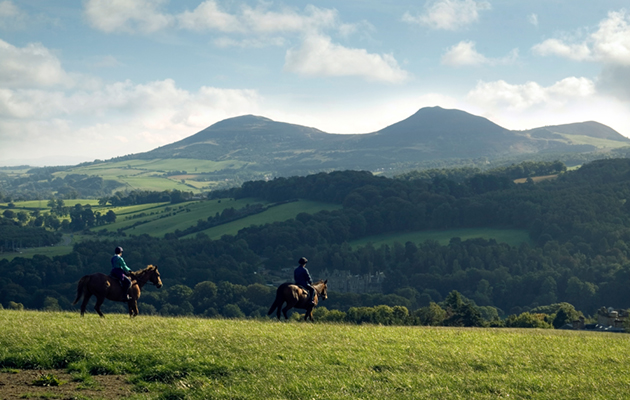Whether planning a holiday or moving lock, stock and barrel, discover the best of Scotland with its Caribbean-style beaches, terrific training terrain and popular native breeds, says Becky Murray
THERE’S something majestic about Scotland, a land like no other. Home to native breeds including the much-loved Clydesdale and the Eriskay pony, Scotland is famed for its scenery and visitors are welcomed with open arms to a unique sense of camaraderie.
But a proud Scot can be a force to be reckoned with and when it comes to equestrianism, they rightly have much to be proud of with top studs, medal-winning riders, and training grounds producing past and future success stories. The long, harsh winters and often lengthy travel to competitions certainly teach riders about grit and determination, but combined with breathtaking views and islands that offer Caribbean-like beaches, there are worse places in the world to be an equestrian.
A dressage rider who knows a lot about this determination is 19-year-old Rachel Evans, who lives in Shapinsay, a small island off Orkney. Despite there being no British Dressage competitions in Orkney, she qualified for the 2020 Petplan Equine Area Festival Championships at Hartpury (which were later cancelled owing to Covid) with her Connemara gelding Kingswells Midnight Blue. Rachel has her eye on further qualifications and is training towards advanced medium level.
{"content":"PHA+4oCcSSBkb27igJl0IGhhdmUgYW4gYXJlbmEgc28gSSBoYXZlIHRvIHNjaG9vbCBvbiB0aGUgYmVhY2gs4oCdIGV4cGxhaW5zIFJhY2hlbCwgd2hvIHRyYXZlbHMgdG8gbWFpbmxhbmQgU2NvdGxhbmQgdGhyb3VnaG91dCB0aGUgeWVhciBmb3IgdHJhaW5pbmcgYW5kIGNvbXBldGl0aW9uLiDigJxJIGhhdmUgdG8gcmlkZSB3aGVuIG90aGVycyBtaWdodCBjaG9vc2Ugbm90IHRvLCB5b3UgaGF2ZSB0byBtYWtlIHRoZSBtb3N0IG9mIGl0LiBUaGVyZeKAmXMgdXN1YWxseSBvbmUgdW5hZmZpbGlhdGVkIGNvbXBldGl0aW9uIGluIE9ya25leSBhIG1vbnRoLCBidXQgYmVjYXVzZSBJ4oCZbSBub3Qgb24gdGhlIG1haW5sYW5kIG9mIE9ya25leSBpdOKAmXMgc3RpbGwgYSAyNS1taW51dGUgYm9hdCBqb3VybmV5IHRvIGdldCB0aGVyZeKApiBhbmQgdGhlIGJvYXQgZG9lc27igJl0IHJ1biBpZiB0aGUgd2VhdGhlciBpcyB0b28gYmFkITwvcD4KPHA+4oCcV2hlbiB0aGUgd2VhdGhlciBpcyBuaWNlLCB0aGVyZSBpcyBubyBiZXR0ZXIgcGxhY2UgdG8gYmUuIFRoZSByb2FkcyBhcmUgcXVpZXQgc28gdGhlIGhhY2tpbmcgaXMgcmVhbGx5IGdvb2QsIGFuZCB5b3Uga25vdyB0aGF0IGlmIHRoZXJlIHdhcyBhIHByb2JsZW0gYW55b25lIHdvdWxkIGhlbHAgeW91LuKAnTwvcD4KPHA+PGRpdiBjbGFzcz0iYWQtY29udGFpbmVyIGFkLWNvbnRhaW5lci0tbW9iaWxlIj48ZGl2IGlkPSJwb3N0LWlubGluZS0yIiBjbGFzcz0iaXBjLWFkdmVydCI+PC9kaXY+PC9kaXY+PHNlY3Rpb24gaWQ9ImVtYmVkX2NvZGUtMzEiIGNsYXNzPSJoaWRkZW4tbWQgaGlkZGVuLWxnIHMtY29udGFpbmVyIHN0aWNreS1hbmNob3IgaGlkZS13aWRnZXQtdGl0bGUgd2lkZ2V0X2VtYmVkX2NvZGUgcHJlbWl1bV9pbmxpbmVfMiI+PHNlY3Rpb24gY2xhc3M9InMtY29udGFpbmVyIGxpc3RpbmctLXNpbmdsZSBsaXN0aW5nLS1zaW5nbGUtc2hhcmV0aHJvdWdoIGltYWdlLWFzcGVjdC1sYW5kc2NhcGUgZGVmYXVsdCBzaGFyZXRocm91Z2gtYWQgc2hhcmV0aHJvdWdoLWFkLWhpZGRlbiI+DQogIDxkaXYgY2xhc3M9InMtY29udGFpbmVyX19pbm5lciI+DQogICAgPHVsPg0KICAgICAgPGxpIGlkPSJuYXRpdmUtY29udGVudC1tb2JpbGUiIGNsYXNzPSJsaXN0aW5nLWl0ZW0iPg0KICAgICAgPC9saT4NCiAgICA8L3VsPg0KICA8L2Rpdj4NCjwvc2VjdGlvbj48L3NlY3Rpb24+PC9wPgo8cD5JVOKAmVMgbm90IGp1c3QgcmlkZXJzIG1hZGUgb2YgdGhlIHRvdWdoIHN0dWZmLiBCb3JuIHRvIGNvcGUgd2l0aCBoYXJzaCBpc2xhbmQgbGlmZSBvZiBjb3Vyc2UgaXMgdGhlIHJvYnVzdCBTaGV0bGFuZCBwb255LCB3aGljaCBoYXMgbG9uZyBpbmhhYml0ZWQgdGhlIFNoZXRsYW5kIElzbGVzIGFuZCBjYW4gYmUgdHJhY2VkIGJhY2sgdG8gdGhlIEJyb256ZSBBZ2UuIFdoaWxlIHRoaXMgbmF0aXZlIGJyZWVkIG1pZ2h0IGJlIHNtYWxsLCBpdCBwYWNrcyBhIHB1bmNoIHdpdGggcGVyc29uYWxpdHkgYW5kIGFiaWxpdHksIGFuZCBoYXMgYmVjb21lIGEgcG9wdWxhciBjaGlsZHJlbuKAmXMgcG9ueSBhY3Jvc3MgdGhlIHdvcmxkLCBzdGFydGluZyB0aGUgY2FyZWVycyBvZiB0aGUgbGlrZXMgb2YgZXZlbnRlciBaYXJhIFRpbmRhbGwgYW5kIGpvY2tleSBTYW0gVHdpc3Rvbi1EYXZpZXMuPC9wPgo8cD5FbGFpbmUgVGFpdCBvZiB0aGUgTWVya2lzYXlyZSBTaGV0bGFuZCBQb255IFN0dWQsIGZvcm1lZCBieSBoZXIgcGFyZW50cyBCYXJiYXJhIGFuZCBHZW9yZ2UgaW4gMTk5NCwgc2F5cyB3aGlsZSB0aGUgcG9uaWVzIHRocml2ZSBvbiB0aGUgaXNsYW5kLCB0aGV5IGFyZSBhbHNvIHZlcnkgdmVyc2F0aWxlIHRvIGxpdmUgZWxzZXdoZXJlIGFuZCB0dXJuIHRoZWlyIGhvb3ZlcyB0byBhIHZhcmlldHkgb2YgY2FyZWVycy4gT25lIG9mIHRoZSBzdHVk4oCZcyBtb3N0IHJlY2VudCBzdWNjZXNzIHN0b3JpZXMgaXMgTWVya2lzYXlyZSBTZWUgRHVibGUsIHdobyBjb21wZXRlZCBpbiB0aGUgU2hldGxhbmQgUG9ueSBHcmFuZCBOYXRpb25hbCBmaW5hbCBhdCBPbHltcGlhLCB0aGUgTG9uZG9uIEludGVybmF0aW9uYWwgSG9yc2UgU2hvdywgaW4gMjAxOCB3aXRoIGhpcyBqb2NrZXkgUG9wcHkgRGFkc29uLjwvcD4KPHA+4oCcSXTigJlzIHZlcnkgbmljZSB3aGVuIHlvdSBnZXQgYSBwaG9uZSBjYWxsIHRvIHNheSBhIHBvbnkgeW914oCZdmUgYnJlZCBoYXMgd29uIGEgY2hhbXBpb25zaGlwIG9yIHF1YWxpZmllZCBzb21ld2hlcmUs4oCdIHNheXMgRWxhaW5lLCB3aG8gaGVyc2VsZiBjb21wZXRlZCBhdCBPbHltcGlhIG9uIGhlciBTaGV0bGFuZCBwb255IFJvYmlucyBCcmFlIEZpcnZhIGluIDE5ODcgYW5kIDE5ODguIOKAnEl04oCZcyBnb29kIHRvIGhlYXIgdGhleeKAmXJlIHN1Y2Nlc3NmdWwgYmVjYXVzZSB0aGF0IG1lYW5zIHlvdeKAmXZlIGRvbmUgYSBnb29kIGpvYi7igJ08L3A+CjxkaXYgY2xhc3M9ImFkLWNvbnRhaW5lciBhZC1jb250YWluZXItLW1vYmlsZSI+PGRpdiBpZD0icG9zdC1pbmxpbmUtMyIgY2xhc3M9ImlwYy1hZHZlcnQiPjwvZGl2PjwvZGl2Pgo8cD5Bbm90aGVyIG11Y2gtbG92ZWQgbmF0aXZlIFNjb3R0aXNoIGJyZWVkIGlzIHRoZSBIaWdobGFuZCBwb255LCBrbm93biBmb3IgdGhlaXIga2luZCB0ZW1wZXJhbWVudCBhbmQgc3RyZW5ndGguIFRoZSBRdWVlbuKAmXMgSGlnaGxhbmQgcG9ueSBzdHVkIGF0IEJhbG1vcmFsIENhc3RsZSBicmVlZHMgd29ya2luZyBwb25pZXMgZm9yIGNhcnJ5aW5nIHN0YWdzIG9mZiB0aGUgaGlsbHMgb2YgdGhlIGVzdGF0ZSDigJMgYXMgd2VsbCBhcyBwcm9kdWNpbmcgc3VjY2Vzc2Z1bCBwb25pZXMgZm9yIHRoZSBzaG93IHJpbmcuIFRoZSBzdHVkIGhhcyBhIGhlcmQgb2YgNDAsIGluY2x1ZGluZyBzdGFsbGlvbnMgQmFsbW9yYWwgU3F1aXJlIGFuZCBCYWxtb3JhbCBNYWpvci48L3A+CjxwPuKAnFdoYXQgd2UgdGhpbmsgYWJvdXQgZmlyc3QgYW5kIGZvcmVtb3N0LCBlc3BlY2lhbGx5IGZvciBhIHdvcmtpbmcgYnJlZWQsIGlzIHRoZSBicmFpbjsgaWYgdGhleSBkb27igJl0IGhhdmUgdGhlIHRlbXBlcmFtZW50IHdpdGggYSB0cmFpbmFibGUgYnJhaW4sIHRoZXJl4oCZcyBubyBwb2ludCBldmVuIHN0YXJ0aW5nLOKAnSBleHBsYWlucyBTeWx2aWEgT3JtaXN0b24sIEJhbG1vcmFsIFN0dWQgbWFuYWdlci4g4oCcSGVyIE1hamVzdHkgVGhlIFF1ZWVuIGlzIHZlcnkgaW52b2x2ZWQgaW4gb3VyIGJyZWVkaW5nIHByb2dyYW1tZSDigJMgSSB3aWxsIGNvbWUgdXAgd2l0aCBhIHN1Z2dlc3Rpb24gYW5kIHRha2UgaXQgdG8gVGhlIFF1ZWVuIGFuZCBzaGXigJlsbCBlaXRoZXIgYWdyZWUgb3IgZGlzYWdyZWUgd2hldGhlciBzaGUgd2FudHMgdG8gZ28gYWhlYWQu4oCdPC9wPgo8ZGl2IGNsYXNzPSJhZC1jb250YWluZXIgYWQtY29udGFpbmVyLS1tb2JpbGUiPjxkaXYgaWQ9InBvc3QtaW5saW5lLTQiIGNsYXNzPSJpcGMtYWR2ZXJ0Ij48L2Rpdj48L2Rpdj4KPHA+SVQgaXNu4oCZdCBqdXN0IG5hdGl2ZSBicmVlZHMgZmx5aW5nIHRoZSBTY290dGlzaCBmbGFnOyBzcG9ydCBob3JzZSBzdHVkcyBpbmNsdWRpbmcgQmFsY29ybW8gU3R1ZCwgTUZTIFN0dWRmYXJtLCBUdXJuYnVsbCBBc2h0b24gU3R1ZCBhbmQgQ2FsZWRvbmlhIERyZXNzYWdlIEhvcnNlcyBhcmUgYW1vbmcgdGhvc2Ugd2l0aCBsb3RzIHRvIHNob3V0IGFib3V0IGFzIHRoZWlyIGhvcnNlcyBlbmpveSB3b3JsZHdpZGUgc3VjY2Vzcy48L3A+CjxwPlRoZSBMb3ctTWl0Y2hlbGxz4oCZIEJhbGNvcm1vIFN0dWQgd2FzIGhvbWUgdG8gdGhlIGxhdGUgYnJlZWRpbmcgc3RhbGxpb24gU2VjdW5kdXMsIG9uZSBvZiB0aGUgZmlyc3Qgd2FybWJsb29kcyB0byBhcnJpdmUgaW4gU2NvdGxhbmQsIGltcG9ydGVkIGJ5IHRoZSBsYXRlIER1Z2FsZCBMb3ctTWl0Y2hlbGwuIEhlIHByb21wdGx5IHB1dCBTY290dGlzaCBicmVlZGluZyBvbiB0aGUgbWFwIHdpdGggY291bnRsZXNzIG9mZnNwcmluZyBjb21wZXRpbmcgaW50ZXJuYXRpb25hbGx5LiBUaGUgc3R1ZCBjb250aW51ZXMgdG8gYnJlZWQgc3VjY2Vzc2Z1bCBob3JzZXMgZnJvbSBzdGFsbGlvbnMgQ29ycmFnaG9lIFN0b3JtIGFuZCBKdW1wZWQgVXAgWi48L3A+CjxkaXYgY2xhc3M9ImFkLWNvbnRhaW5lciBhZC1jb250YWluZXItLW1vYmlsZSI+PGRpdiBpZD0icG9zdC1pbmxpbmUtNSIgY2xhc3M9ImlwYy1hZHZlcnQiPjwvZGl2PjwvZGl2Pgo8cD5TYW5kcmEgTG93LU1pdGNoZWxsIHNheXMgc2hl4oCZcyBwcm91ZCB0byBiZSBTY290dGlzaCBhbmQgZGVzY3JpYmVzIHRoZSBsYW5kc2NhcGUgYXMgYSDigJxwbGF5Z3JvdW5k4oCdIGZvciBlZHVjYXRpbmcgeW91bmcgaG9yc2VzLjwvcD4KPHA+4oCcSXTigJlzIGEgZ3JlYXQgc3RhcnRpbmcgZ3JvdW5kIGluIHRlcm1zIG9mIHRoZSB2YXJpYXRpb24gaW4gdGhlIGNsaW1hdGUsIGdyb3VuZCBhbmQgdGVycmFpbiwgYnV0IEkgdGhpbmsgd2hlbiB5b3UgZ2V0IHRvIGEgY2VydGFpbiBsZXZlbCB5b3UgaGF2ZSB0byB0YWtlIGEgY2hhbmNlIGFuZCBtb3ZlIG9uIGFuZCBnZXQgb3V0IGludG8gdGhlIHdvcmxkLOKAnSBzaGUgZXhwbGFpbnMuIOKAnFNjb3R0IEJyYXNoIGhhcyBiZWVuIGEgZmFudGFzdGljIGluc3BpcmF0aW9uIGZvciByaWRlcnMg4oCTIGhl4oCZcyBzaG93biBpdCBjYW4gYmUgZG9uZS4gSGUgYWx3YXlzIGhhZCBzZXJpb3VzIHRhbGVudCwgYnV0IGhlIGFsc28gaGFzIGZhbnRhc3RpYyBkcml2ZS7igJ08L3A+CjxwPkNPTVBFVElUT1JTIGluIFNjb3RsYW5kIGhhdmUgYSBjaG9pY2Ugb2YgdmVudWVzIG9mZmVyaW5nIEJyaXRpc2ggU2hvd2p1bXBpbmcgYW5kIEJyaXRpc2ggRHJlc3NhZ2UgaW5jbHVkaW5nIHRoZSBDYWJpbiBFcXVlc3RyaWFuIENlbnRyZSwgQWJlcmRlZW5zaGlyZTsgSG93ZSBFcXVlc3RyaWFuLDxiciAvPgpGaWZlOyB0aGUgU2NvdHRpc2ggTmF0aW9uYWwgRXF1ZXN0cmlhbiBDZW50cmUsIFdlc3QgTG90aGlhbjsgYW5kIE1vcnJpcyBFcXVlc3RyaWFuIENlbnRyZSBhbmQgTXVpcm1pbGwgRXF1ZXN0cmlhbiBDZW50cmUsIEVhc3QgQXlyc2hpcmUuPC9wPgo8cD5UaGUgQnJpdGlzaCBFdmVudGluZyBvZmZlcmluZyBpbiBTY290bGFuZCBoYXMgcmVkdWNlZCBpbiByZWNlbnQgeWVhcnMgYXMgb3JnYW5pc2VycyBoYXZlIHJldGlyZWQgb3IgbW92ZWQgYXdheSBmcm9tIGFmZmlsaWF0ZWQgZXZlbnRzIHdpdGggY29tcGV0aXRvciBmYXZvdXJpdGVzIEFzd2FubGV5LCBGbG9vcnMgQ2FzdGxlIGFuZCBFZ2xpbnRvbiBzb21lIG9mIHRoZSBldmVudHMgdG8gZHJvcCBvZmYgdGhlIGNhbGVuZGFyLjwvcD4KPHA+QnVyZ2llLCBIb3BldG91biwgYW5kIEtpcnJpZW11aXIgYXJlIGFtb25nIHRob3NlIHRoYXQgY29udGludWUgdG8gd2VsY29tZSByaWRlcnMgZHVyaW5nIHRoZSBsaW1pdGVkIFNjb3R0aXNoIHNlYXNvbi48L3A+CjxwPkFuZCB3aGlsZSBjb21wZXRpdG9ycyBhc3BpcmluZyB0byB0aGUgaGlnaGVyIGxldmVscyBvZnRlbiBzcGVuZCBtYW55IGhvdXJzIG9uIHRoZSByb2FkIGhlYWRpbmcgc291dGgsIHRoZSBSb3lhbCBIaWdobGFuZCBTaG93IGFuZCBCbGFpciBDYXN0bGUgSW50ZXJuYXRpb25hbCBIb3JzZSBUcmlhbHMgcHVsbCBpbiB0aGUgY3JlYW0gb2YgdGhlIGNyb3AgdXAgbm9ydGgsIGFzIHRvcCBzaG93aW5nIHJpZGVycywgc2hvd2p1bXBlcnMgYW5kIGV2ZW50ZXJzIGRlc2NlbmQgYW5udWFsbHkuPC9wPgo8cD7igJxUaGUgUm95YWwgSGlnaGxhbmQgaXMgYSBiaWcgZHJhdyBmb3IgdXMsIGV2ZXJ5b25lIHdhbnRzIHRvIHJpZGUgdGhlcmUg4oCTIGl0IGhhcyBhIGdyZWF0IGF0bW9zcGhlcmUgYW5kIHlvdSBkb27igJl0IGdldCBhIG5pY2VyIHBsYWNlIHRoYW4gQmxhaXIgQ2FzdGxlLOKAnSBzYXlzIFNhbmRyYS48L3A+CjxwPk5ldyBaZWFsYW5kIE9seW1waWMgcmlkZXIgQ2Fyb2xpbmUgUG93ZWxsLCB3aG8gd2FzIGJhc2VkIGluIFNjb3RsYW5kIGZvciBhbG1vc3QgMjAgeWVhcnMsIGhhcyBmb25kIG1lbW9yaWVzIG9mIEJsYWlyIENhc3RsZS48L3A+CjxwPuKAnEJsYWlyIHdhcyBhbWF6aW5nIOKAkyB0aGV5IGhhZCBzb21lIGV4Y2VsbGVudCBldmVudHMs4oCdIHNoZSByZWNhbGxzLiDigJxJdCBjZXJ0YWlubHkgaXNu4oCZdCBhIHBsYWNlIHRvIGdvIHdpdGggaG9yc2VzIHRoYXQgZG9u4oCZdCBrbm93IGhvdyB0byBnZXQgdXAgYW5kIGRvd24gaGlsbHMhPC9wPgo8cD7igJxJIG1pc3MgU2NvdGxhbmQgYW5kIHRoZSBjYW1hcmFkZXJpZSwgaXQgaGFkIGEgY2xvc2Uta25pdCBjb21tdW5pdHkgYW5kIHdhcyBnb29kIGZ1bi4gS2Vsc28gd2FzIGEgbG92ZWx5IHBsYWNlIHRvIGtlZXAgaG9yc2VzIOKAkyB0aGV5IGxpdmVkIG91dCB0aGUgd2hvbGUgdGltZS48L3A+CjxwPuKAnFNjb3RsYW5kIGhhZCB0aGUgbW9zdCBhbWF6aW5nIHJpZGluZyBhbmQgb3BlbiBzcGFjZSwgd2hlcmVhcyBkb3duIHNvdXRoIGl0IGNhbiBnZXQgYSBiaXQgY2xhdXN0cm9waG9iaWMu4oCdPC9wPgo8cD5PbHltcGljIHRlYW0gZ29sZCBtZWRhbGxpc3QgU2NvdHQgQnJhc2gsIHdobyB3YXMgYm9ybiBhbmQgcmFpc2VkIGluIFBlZWJsZXMsIG1heSBzcGVuZCBtdWNoIG9mIGhpcyB0aW1lIGZseWluZyB0aGUgQnJpdGlzaCBmbGFnIG9uIHRoZSBpbnRlcm5hdGlvbmFsIHNob3dqdW1waW5nIGNpcmN1aXQsIGJ1dCBoZSBzcGVha3MgcHJvdWRseSBvZiBoaXMgaG9tZSBjb3VudHJ5IGFuZCByZXR1cm5zIHRvIFBlZWJsZXMgYXMgbXVjaCBhcyBoZSBjYW4uPC9wPgo8cD7igJxUaGUgaGlsbHdvcmsgSSBjb3VsZCBkbyBpbiBTY290bGFuZCB3YXMgcmVhbGx5IGJlbmVmaWNpYWwgdG8gbXkgaG9yc2Vz4oCZIHRyYWluaW5nIHByb2dyYW1tZSwgd2hpY2ggdGhleSBkb27igJl0IGdldCBvbiB0aGUgQ29udGluZW50LiBJZiB5b3UgZ28gdG8gYSB5YXJkIGluIEJlbGdpdW0gb3IgR2VybWFueSwgaXTigJlzIHJlYWxseSBoYXJkIHRvIGdldCB0cmFkaXRpb25hbCB0ZXJyYWluIHRvIHRyYWluIGhvcnNlcyBhbmQgZGV2ZWxvcCB0aGUgbXVzY2xlcyBpbiB0aGUgY29ycmVjdCB3YXksIHNvIHRoYXTigJlzIGEgcmVhbCBiZW5lZml0IG9mIGxpdmluZyBpbiBTY290bGFuZCzigJ0gaGUgc2F5cy48L3A+CjxwPuKAnFNjb3RsYW5kIGhhcyBhIHN0cm9uZyBwbGFjZSBpbiBteSBoZWFydCwgSeKAmWxsIGFsd2F5cyByZWdhcmQgaXQgYXMgaG9tZS4gSSBzdGlsbCBwdXQgbXkgeW91bmcgaG9yc2VzIHRoZXJlIHRvIGJlIGJyb3VnaHQgdXAgaW4gdGhhdCBlbnZpcm9ubWVudCDigJMgdGhlcmXigJlzIG5vIGJldHRlciBwbGFjZS7igJ08L3A+CjxkaXYgaWQ9ImF0dGFjaG1lbnRfNzQ5ODExIiBzdHlsZT0id2lkdGg6IDE0MTBweCIgY2xhc3M9IndwLWNhcHRpb24gYWxpZ25jZW50ZXIiPjxpbWcgZmV0Y2hwcmlvcml0eT0iaGlnaCIgZGVjb2Rpbmc9ImFzeW5jIiBhcmlhLWRlc2NyaWJlZGJ5PSJjYXB0aW9uLWF0dGFjaG1lbnQtNzQ5ODExIiBjbGFzcz0ibGF6eWxvYWQgYmx1ci11cCBzaXplLWZ1bGwgd3AtaW1hZ2UtNzQ5ODExIiBkYXRhLXByb2Nlc3NlZCBzcmM9Imh0dHBzOi8va2V5YXNzZXRzLnRpbWVpbmN1ay5uZXQvaW5zcGlyZXdwL2xpdmUvd3AtY29udGVudC91cGxvYWRzL3NpdGVzLzE0LzIwMTcvMDMvbmV3LWhoLXBsYWNlaG9sZGVyLTIwMHgyMDAucG5nIiBkYXRhLXNyYz0iaHR0cHM6Ly9rZXlhc3NldHMudGltZWluY3VrLm5ldC9pbnNwaXJld3AvbGl2ZS93cC1jb250ZW50L3VwbG9hZHMvc2l0ZXMvMTQvMjAyMS8wNi9IQUgzMTEuZnRfU2NvdGxhbmRwYXJhZGlzZS5tZHhmamtfYWxhbXkuanBnIiBhbHQ9IiIgd2lkdGg9IjE0MDAiIGhlaWdodD0iNzg4IiBkYXRhLXNpemVzPSJhdXRvIiBkYXRhLXNyY3NldD0iaHR0cHM6Ly9rZXlhc3NldHMudGltZWluY3VrLm5ldC9pbnNwaXJld3AvbGl2ZS93cC1jb250ZW50L3VwbG9hZHMvc2l0ZXMvMTQvMjAyMS8wNi9IQUgzMTEuZnRfU2NvdGxhbmRwYXJhZGlzZS5tZHhmamtfYWxhbXkuanBnIDE0MDB3LCBodHRwczovL2tleWFzc2V0cy50aW1laW5jdWsubmV0L2luc3BpcmV3cC9saXZlL3dwLWNvbnRlbnQvdXBsb2Fkcy9zaXRlcy8xNC8yMDIxLzA2L0hBSDMxMS5mdF9TY290bGFuZHBhcmFkaXNlLm1keGZqa19hbGFteS0zMDB4MTY5LmpwZyAzMDB3LCBodHRwczovL2tleWFzc2V0cy50aW1laW5jdWsubmV0L2luc3BpcmV3cC9saXZlL3dwLWNvbnRlbnQvdXBsb2Fkcy9zaXRlcy8xNC8yMDIxLzA2L0hBSDMxMS5mdF9TY290bGFuZHBhcmFkaXNlLm1keGZqa19hbGFteS02MzB4MzU1LmpwZyA2MzB3LCBodHRwczovL2tleWFzc2V0cy50aW1laW5jdWsubmV0L2luc3BpcmV3cC9saXZlL3dwLWNvbnRlbnQvdXBsb2Fkcy9zaXRlcy8xNC8yMDIxLzA2L0hBSDMxMS5mdF9TY290bGFuZHBhcmFkaXNlLm1keGZqa19hbGFteS0xMzV4NzYuanBnIDEzNXcsIGh0dHBzOi8va2V5YXNzZXRzLnRpbWVpbmN1ay5uZXQvaW5zcGlyZXdwL2xpdmUvd3AtY29udGVudC91cGxvYWRzL3NpdGVzLzE0LzIwMjEvMDYvSEFIMzExLmZ0X1Njb3RsYW5kcGFyYWRpc2UubWR4ZmprX2FsYW15LTMyMHgxODAuanBnIDMyMHcsIGh0dHBzOi8va2V5YXNzZXRzLnRpbWVpbmN1ay5uZXQvaW5zcGlyZXdwL2xpdmUvd3AtY29udGVudC91cGxvYWRzL3NpdGVzLzE0LzIwMjEvMDYvSEFIMzExLmZ0X1Njb3RsYW5kcGFyYWRpc2UubWR4ZmprX2FsYW15LTYyMHgzNDkuanBnIDYyMHcsIGh0dHBzOi8va2V5YXNzZXRzLnRpbWVpbmN1ay5uZXQvaW5zcGlyZXdwL2xpdmUvd3AtY29udGVudC91cGxvYWRzL3NpdGVzLzE0LzIwMjEvMDYvSEFIMzExLmZ0X1Njb3RsYW5kcGFyYWRpc2UubWR4ZmprX2FsYW15LTkyMHg1MTguanBnIDkyMHcsIGh0dHBzOi8va2V5YXNzZXRzLnRpbWVpbmN1ay5uZXQvaW5zcGlyZXdwL2xpdmUvd3AtY29udGVudC91cGxvYWRzL3NpdGVzLzE0LzIwMjEvMDYvSEFIMzExLmZ0X1Njb3RsYW5kcGFyYWRpc2UubWR4ZmprX2FsYW15LTEyMjB4Njg3LmpwZyAxMjIwdyIgc2l6ZXM9IihtYXgtd2lkdGg6IDE0MDBweCkgMTAwdncsIDE0MDBweCIgLz48cCBpZD0iY2FwdGlvbi1hdHRhY2htZW50LTc0OTgxMSIgY2xhc3M9IndwLWNhcHRpb24tdGV4dCI+U2NvdGxhbmTigJlzIENhcmliYmVhbi1saWtlIGJlYWNoZXMgYW5kIHZhcnlpbmcgdGVycmFpbiBtYWtlIGl0IGFuIGlkZWFsIHBsYWNlIGZvciB0cmFpbmluZyBob3JzZXM8L3A+PC9kaXY+CjxwPkVWRU5USU5HIGxlZ2VuZCBhbmQgT2x5bXBpYyBtZWRhbGxpc3QgSWFuIFN0YXJrIHNheXMgaXQgd2FzIG5ldmVyIGFuIGlzc3VlIGtlZXBpbmcgaGlzIGhvcnNlcyBmaXQgZHVyaW5nIGhpcyBldmVudGluZyBjYXJlZXIgYW5kIGNyZWRpdHMgdGhlIFNjb3R0aXNoIGh1bnRpbmcgc2NlbmUgYXMgYW4gaW1wb3J0YW50IHBhcnQgb2YgaGlzIHByZXBhcmF0aW9uLiBJYW4gcmVjYWxscyBoaXMgZmlyc3QgQmFkbWludG9uIHdpbm5lciDigJMgaW4gMTk4NiB3aXRoIDxhIGhyZWY9Imh0dHBzOi8vd3d3LmhvcnNlYW5kaG91bmQuY28udWsvcGx1cy9mZWF0dXJlcy1wbHVzL3Npci13YXR0aWUtaGUtaGFkLWEtaGVhcnQtb2YtZ29sZC1hbmQtd291bGQtYWx3YXlzLWJ1c3QtYS1ndXQtZm9yLW1lLTc0OTgwNCIgdGFyZ2V0PSJfYmxhbmsiIHJlbD0ibm9vcGVuZXIgbm9yZWZlcnJlciI+U2lyIFdhdHRpZTwvYT4g4oCTIHdob20gYm90aCBoZSBhbmQgaGlzIHdpZmUgSmVubnkgaHVudGVkLjwvcD4KPHA+4oCcV2Ugd2VyZSBsYXN0IHRvIGdvIGF0IEJhZG1pbnRvbiBpbiBib3R0b21sZXNzIGNvbmRpdGlvbnMgYW5kIFNpciBXYXR0aWUganVzdCB0aG91Z2h0IHRoaXMgd2FzIG5vcm1hbCzigJ0gaGUgc2F5cy48L3A+CjxwPuKAnFdlIHdlbnQgc2FpbGluZyByb3VuZCBpbnNpZGUgdGhlIHRpbWUgYW5kIHdvbiB0aGUgY29tcGV0aXRpb24uIFRoZXkgbGVhcm4gYSBodWdlIGFtb3VudCBodW50aW5nOyBpdCB0ZWFjaGVzIHRoZW0gYSBsb3QgYWJvdXQgbG9va2luZyBhZnRlciB0aGVtc2VsdmVzLCBhbmQgSSBzdGlsbCB0YWtlIG15IHlvdW5nIGhvcnNlcyBodW50aW5nLuKAnTwvcD4KPHA+QW5kIHRoZXJlIGlzIHBsZW50eSBvZiBodW50aW5nIGNvdW50cnkgdG8gZW5qb3kgaW4gU2NvdGxhbmQsIHdpdGggaHVudHMgaW5jbHVkaW5nIHRoZSBMYXVkZXJhbGUsIEJlcndpY2tzaGlyZSBhbmQgdGhlIER1a2Ugb2YgQnVjY2xldWNoLCB0aGUgbGF0dGVyIG9mIHdoaWNoIElhbiB3YXMgYSBmb3JtZXIgZmllbGQgbWFzdGVyIGFuZCBqb2ludC1tYXN0ZXIuPC9wPgo8cD5PbmUgdGhpbmcgdGhhdOKAmXMgY2xlYXIgaXMgdGhhdCB0aG9zZSB3aG8gYXJlIGJhc2VkIGluIFNjb3RsYW5kIHNwZWFrIGhpZ2hseSBvZiBpdCwgYW5kIHRob3NlIHdobyBtb3ZlIG9uIHdpbGwgYWx3YXlzIHJlbWVtYmVyIGl0IGFzIGhvbWUuPC9wPgo8aDM+PGEgaHJlZj0iaHR0cHM6Ly93d3cuaG9yc2VhbmRob3VuZC5jby51ay90YWcvaG9yc2UtcmlkaW5nLWhvbGlkYXlzIiB0YXJnZXQ9Il9ibGFuayIgcmVsPSJub29wZW5lciBub3JlZmVycmVyIj5SSURJTkcgSE9MSURBWVM8L2E+PC9oMz4KPHA+PGltZyBkZWNvZGluZz0iYXN5bmMiIGNsYXNzPSJsYXp5bG9hZCBibHVyLXVwIGFsaWduY2VudGVyIHNpemUtZnVsbCB3cC1pbWFnZS03NDk4MDkiIGRhdGEtcHJvY2Vzc2VkIHNyYz0iaHR0cHM6Ly9rZXlhc3NldHMudGltZWluY3VrLm5ldC9pbnNwaXJld3AvbGl2ZS93cC1jb250ZW50L3VwbG9hZHMvc2l0ZXMvMTQvMjAxNy8wMy9uZXctaGgtcGxhY2Vob2xkZXItMjAweDIwMC5wbmciIGRhdGEtc3JjPSJodHRwczovL2tleWFzc2V0cy50aW1laW5jdWsubmV0L2luc3BpcmV3cC9saXZlL3dwLWNvbnRlbnQvdXBsb2Fkcy9zaXRlcy8xNC8yMDIxLzA2L0hBSDMxMS5mdF9TY290bGFuZHBhcmFkaXNlLmJveF9iMjc1YzFfYWxhbXktY29weS0xLmpwZyIgYWx0PSIiIHdpZHRoPSIxNDAwIiBoZWlnaHQ9Ijc4OCIgZGF0YS1zaXplcz0iYXV0byIgZGF0YS1zcmNzZXQ9Imh0dHBzOi8va2V5YXNzZXRzLnRpbWVpbmN1ay5uZXQvaW5zcGlyZXdwL2xpdmUvd3AtY29udGVudC91cGxvYWRzL3NpdGVzLzE0LzIwMjEvMDYvSEFIMzExLmZ0X1Njb3RsYW5kcGFyYWRpc2UuYm94X2IyNzVjMV9hbGFteS1jb3B5LTEuanBnIDE0MDB3LCBodHRwczovL2tleWFzc2V0cy50aW1laW5jdWsubmV0L2luc3BpcmV3cC9saXZlL3dwLWNvbnRlbnQvdXBsb2Fkcy9zaXRlcy8xNC8yMDIxLzA2L0hBSDMxMS5mdF9TY290bGFuZHBhcmFkaXNlLmJveF9iMjc1YzFfYWxhbXktY29weS0xLTMwMHgxNjkuanBnIDMwMHcsIGh0dHBzOi8va2V5YXNzZXRzLnRpbWVpbmN1ay5uZXQvaW5zcGlyZXdwL2xpdmUvd3AtY29udGVudC91cGxvYWRzL3NpdGVzLzE0LzIwMjEvMDYvSEFIMzExLmZ0X1Njb3RsYW5kcGFyYWRpc2UuYm94X2IyNzVjMV9hbGFteS1jb3B5LTEtNjMweDM1NS5qcGcgNjMwdywgaHR0cHM6Ly9rZXlhc3NldHMudGltZWluY3VrLm5ldC9pbnNwaXJld3AvbGl2ZS93cC1jb250ZW50L3VwbG9hZHMvc2l0ZXMvMTQvMjAyMS8wNi9IQUgzMTEuZnRfU2NvdGxhbmRwYXJhZGlzZS5ib3hfYjI3NWMxX2FsYW15LWNvcHktMS0xMzV4NzYuanBnIDEzNXcsIGh0dHBzOi8va2V5YXNzZXRzLnRpbWVpbmN1ay5uZXQvaW5zcGlyZXdwL2xpdmUvd3AtY29udGVudC91cGxvYWRzL3NpdGVzLzE0LzIwMjEvMDYvSEFIMzExLmZ0X1Njb3RsYW5kcGFyYWRpc2UuYm94X2IyNzVjMV9hbGFteS1jb3B5LTEtMzIweDE4MC5qcGcgMzIwdywgaHR0cHM6Ly9rZXlhc3NldHMudGltZWluY3VrLm5ldC9pbnNwaXJld3AvbGl2ZS93cC1jb250ZW50L3VwbG9hZHMvc2l0ZXMvMTQvMjAyMS8wNi9IQUgzMTEuZnRfU2NvdGxhbmRwYXJhZGlzZS5ib3hfYjI3NWMxX2FsYW15LWNvcHktMS02MjB4MzQ5LmpwZyA2MjB3LCBodHRwczovL2tleWFzc2V0cy50aW1laW5jdWsubmV0L2luc3BpcmV3cC9saXZlL3dwLWNvbnRlbnQvdXBsb2Fkcy9zaXRlcy8xNC8yMDIxLzA2L0hBSDMxMS5mdF9TY290bGFuZHBhcmFkaXNlLmJveF9iMjc1YzFfYWxhbXktY29weS0xLTkyMHg1MTguanBnIDkyMHcsIGh0dHBzOi8va2V5YXNzZXRzLnRpbWVpbmN1ay5uZXQvaW5zcGlyZXdwL2xpdmUvd3AtY29udGVudC91cGxvYWRzL3NpdGVzLzE0LzIwMjEvMDYvSEFIMzExLmZ0X1Njb3RsYW5kcGFyYWRpc2UuYm94X2IyNzVjMV9hbGFteS1jb3B5LTEtMTIyMHg2ODcuanBnIDEyMjB3IiBzaXplcz0iKG1heC13aWR0aDogMTQwMHB4KSAxMDB2dywgMTQwMHB4IiAvPjwvcD4KPHA+U0NPVExBTkQgb2ZmZXJzIGEgcGFyYWRpc2UgZm9yIHRob3NlIHNlZWtpbmcgcmlkaW5nIGhvbGlkYXlzIGZyb20gYmVhY2hlcyB0byBtb3VudGFpbnMgYW5kIGV2ZXJ5dGhpbmcgaW4gYmV0d2Vlbi4gQ2hlY2sgb3V0IHRoZXNlIHlhcmRzLjwvcD4KPHA+4pePIEhpZ2hsYW5kIEhvcnNlIEZ1biBpbiBJbnZlcm5lc3Mtc2hpcmUgb2ZmZXJzIHRhaWxvci1tYWRlIGV4cGVyaWVuY2VzIG9uIEhpZ2hsYW5kIHBvbmllcywgaW5jbHVkaW5nIGZpdmUtZGF5IHRyYWlsIHJpZGVzIG9yIG11bnJvIGJhZ2dpbmcgKGNsaW1iaW5nIHBlYWtzKSBieSBob3JzZWJhY2suPGJyIC8+CmhpZ2hsYW5kaG9yc2VmdW4uY29tPC9wPgo8cD7il48gTG9jaCBMb21vbmQgUG9ueSBUcmVra2luZyBvZmZlcnMgYSByaWRpbmcgZXhwZXJpZW5jZSB3aXRoIHNwZWN0YWN1bGFyIHN1cnJvdW5kaW5ncyBpbiBhbmQgYXJvdW5kIExvY2ggTG9tb25kIGFuZCB0aGUgTmF0aW9uYWwgUGFyay48YnIgLz4KbG9tb25kLXBvbnl0cmVrcy5jby51azwvcD4KPHA+4pePIFRoZSBTaGV0bGFuZCBQb255IEV4cGVyaWVuY2UgaW4gQnVycmEsIFNoZXRsYW5kIElzbGFuZHMsIG9mZmVycyBhIGJlYWNoIGV4cGVyaWVuY2Ugc3VpdGFibGUgZm9yIGZhbWlsaWVzLCB3aXRoIHBsZW50eSBvZiBwaG90b2dyYXBoIG9wcG9ydHVuaXRpZXMuIHRoZXNoZXRsYW5kcG9ueWV4cGVyaWVuY2UuY29tPC9wPgo8ZGl2IGNsYXNzPSJpbmplY3Rpb24iPjwvZGl2Pgo8cD7il48gVHJhaWdoIE1tb2ggUG9ueSBUcmVra2luZyBvbiB0aGUgSXNsZSBvZiBMZXdpcyBvZmZlcnMgdHdvIG1pbGVzIG9mIGJlYWNoIHJpZGluZyB3aXRoIGFtcGxlIG9wcG9ydHVuaXRpZXMgdG8gZW5qb3kgYSBnb29kIGdhbGxvcC4gdG9sc3RhNDEuY29tPC9wPgo8cD7il48gTG9jaCBOZXNzIFJpZGluZyBvZmZlcnMgaG9saWRheSBwYWNrYWdlcyBmb3IgZXhwZXJpZW5jZWQgcmlkZXJzLCBhbmQgeW91ciBvd24gaG9yc2UgaXMgd2VsY29tZSB0b28uPGJyIC8+CmxvY2huZXNzcmlkaW5nLmNvLnVrPC9wPgo8cD4K"}
This report can also be read in Horse & Hound magazine, on sale date 24 June 2021
You may also be interested in…
Credit: Peter Nixon
Credit: Alamy Stock Photo
‘We have the perfect combination of spectacular countryside and a heritage of long-established trails’
H&H senior news writer
Since joining H&H in 2018, Becky has covered a broad range of equestrian news including welfare matters, veterinary studies, FEI Tribunal hearings and road safety campaigns. She has also interviewed top riders including Scott Brash, John Whitaker and Ian Stark, to name just a few. Becky’s reporting has taken her to Canada for Spruce Meadows and France for Pau five-star, as well as the Royal Highland and Blair Castle International Horse Trials closer to home. She was also a key part of the remote reporting team for the Tokyo Olympics and the Europeans.




